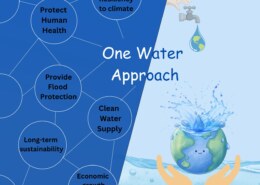Maintaining healthy wetlands is essential for biodiversity preservation, climate adaptability, and human health. Talk about it. What systems are in place in India to make this happen? (Answer in 250 words)
Role of Public Participation in the EIA Process and Its Influence on Project Outcomes in India 1. Importance of Public Participation in EIA Public participation is a critical component of the Environmental Impact Assessment (EIA) process. It ensures that the perspectives and concerns of affected comRead more
Role of Public Participation in the EIA Process and Its Influence on Project Outcomes in India
1. Importance of Public Participation in EIA
Public participation is a critical component of the Environmental Impact Assessment (EIA) process. It ensures that the perspectives and concerns of affected communities are considered, leading to more informed and balanced decision-making.
- Informed Decision-Making: Public participation helps in gathering diverse viewpoints and local knowledge, which can enhance the accuracy of the EIA report. This is crucial for identifying potential environmental and social impacts that may not be apparent to project developers or regulators alone.
- Increased Transparency: Engaging the public in the EIA process fosters transparency, as project details and potential impacts are made available to stakeholders. This transparency helps build trust between the public and project developers or government agencies.
2. Mechanisms of Public Participation
Public participation in the EIA process typically involves several mechanisms:
- Public Hearings: These are organized to allow stakeholders to express their views and concerns about the proposed project. For example, in the Kashmir Hydro-Electric Project, public hearings were conducted to discuss the potential impacts on local communities and biodiversity.
- Consultation Meetings: Regular meetings with affected communities provide a platform for continuous dialogue throughout the EIA process. The Narmada Bachao Andolan movement used such consultations to highlight the adverse effects of the Sardar Sarovar Dam on local communities.
- Submission of Written Comments: Stakeholders can submit written feedback on the draft EIA report, which must be addressed by the project proponent. The Delhi-Gurgaon Expressway Project saw significant public input through written comments that led to modifications in the project plan.
3. Influence on Project Outcomes
Public participation can significantly influence project outcomes in several ways:
- Modification of Project Design: Feedback from the public can lead to changes in project design to minimize negative impacts. For instance, the Panki Thermal Power Plant project was modified to include better pollution control measures based on public concerns.
- Enhanced Mitigation Measures: Public input often results in stronger mitigation measures to address potential environmental and social impacts. The Mumbai Coastal Road Project incorporated additional environmental safeguards following public consultations.
- Conflict Resolution: Engaging with the public can help resolve conflicts and address grievances, thereby reducing resistance and enhancing project acceptance. The Madhya Pradesh Bamboo Project was refined to better address community concerns about resource use and livelihoods.
4. Challenges and Limitations
Despite its benefits, public participation in the EIA process faces several challenges:
- Limited Awareness and Capacity: Many stakeholders, especially in marginalized communities, may lack awareness or capacity to effectively participate in the EIA process. Efforts are needed to build local capacity and ensure that all voices are heard.
- Tokenism: There is a risk of superficial participation where public inputs are not genuinely considered in decision-making. To address this, the EIA process must ensure that public feedback is integrated into project planning and implementation.
5. Recent Developments and Examples
Recent initiatives and examples highlight the evolving role of public participation in the EIA process:
- EIA Notification 2020: The Government of India’s revised EIA Notification 2020 emphasizes the need for public consultations, including mandatory public hearings and the submission of public feedback on draft reports. However, concerns have been raised about the adequacy of these provisions in ensuring genuine public involvement.
- Chardham Project: The Chardham All Weather Road Project faced significant public opposition and legal challenges due to environmental concerns raised during the EIA process. The Supreme Court of India intervened to ensure that the project complies with environmental regulations and addresses public concerns.
Conclusion
Public participation in the EIA process plays a crucial role in ensuring that environmental and social impacts are comprehensively assessed and addressed. By fostering transparency, improving decision-making, and enhancing project outcomes, it contributes to more sustainable and equitable development. However, for public participation to be effective, it must be meaningful, inclusive, and integrated into all stages of the EIA process.
See less


The Ramsar Convention on Wetlands defines wetlands as "areas of marsh, fen, peat, and or water, whether natural or artificial, permanent or temporary, with water that is static or flowing, fresh, brackish or salt, including areas of marine water the depth of which at low tide does not exceed six metRead more
The Ramsar Convention on Wetlands defines wetlands as “areas of marsh, fen, peat, and or water, whether natural or artificial, permanent or temporary, with water that is static or flowing, fresh, brackish or salt, including areas of marine water the depth of which at low tide does not exceed six meters.”
Wetlands include rivers, marshes, bogs, mangroves, mudflats, ponds, swamps, billabongs, lagoons, lakes, and floodplains are critical in performing regulating and provisioning services such as:
Despite their huge importance, wetlands are declining all over the world at three times the rates of forests. There are multiple mechanisms and initiatives for wetlands conservation and management in India as follows:
The Wetlands Change Atlas 2022 attributes the decline of wetlands in India due to multiple reasons such as catchment degradation, alteration of hydrological regimes, pollution, invasive species, over- harvesting, unregulated tourism, and climate change. To ensure that the wetlands continue to deliver the vital ecosystem services that humanity requires, their prioritization, protection, restoration, better management, and monitoring are needed.
See less